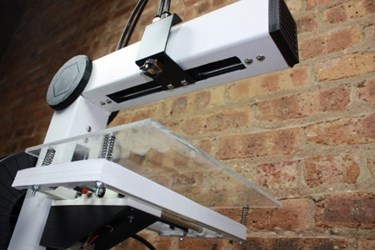3D Printing To Make Facial Prosthetics Affordable
By Chuck Seegert, Ph.D.

For patients who have had facial reconstruction and need prostheses, cheaper and more versatile options may have arrived. New technology from the University of Miami can create life-like prosthetics, even from remote locations.
Eye cancer is a disease that can have relatively high mortality rates and affects thousands of people per year in the United States alone. Lives can be saved by performing procedures like exenteration, which involves the removal of the tissue inside the eye socket along with some of the surrounding the area. While this saves the patients’ lives, it also leaves them with a large deficit in their facial region, a condition that may cause patients to feel stigmatized.
Facial prosthetics sometimes help make a deficit less noticeable, but they can cost as much as $10,000 to $15,000, according to a recent press release from the American Academy of Ophthalmology. Usually this cosmetic device is not covered by health insurance, and it can take weeks to produce by an artisan called an ocularist. These factors often make prostheses unavailable for many patients.
For David Tse, M.D., professor of ophthalmology at the Bascom Palmer Eye Institute in Florida and the Nasser Ibrahim Al-Rashid chair in ophthalmic plastic, orbital surgery, and oncology, the current state of affairs was unacceptable. Dr. Tse treated a child with eye cancer whose family could not afford an ocularist, which led him to consider 3D printing as an option.
"Hopefully, using this quick and less expensive 3-D printing process, we can make an affordable facial prosthesis for her and also help thousands of other people like her who lack the resources to obtain one through an ocularist," said Dr. Tse, in the press release.
The prosthesis is designed by taking a 3D scan of the patient’s face and then inverting the data from the normal side so it overlaps the deficit. A scan of the deficit allows the two sets of data to be superimposed and adjusted to create a believable substitute. The printed material includes nanoparticles that can be adjusted to match any skin color, while adding mechanical strength to the material.
"Once we have a patient scanned, we have the mold, so we can create a new prosthesis in no time," said Landon Grace, Ph.D., director of the Composite Materials Lab at the University of Miami and an assistant professor of mechanical and aerospace engineering, in the press release. "Our long-term goal is to help patients anywhere in the world. We could get a mobile scan, download the data in Miami, print out the prosthesis and ship it back to the patient the next day."
Additive manufacturing continues to accelerate in the medical device space. Facial reconstruction recently took an interesting turn in this direction when 3D printed implant systems were approved by the FDA.
Image Credit: By Eventorbot (Own work) [GFDL (http://www.gnu.org/copyleft/fdl.html) or CC-BY-SA-3.0 (http://creativecommons.org/licenses/by-sa/3.0)], via Wikimedia Commons
